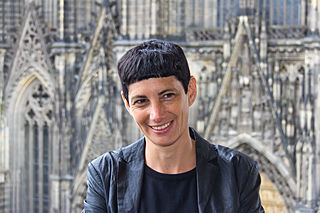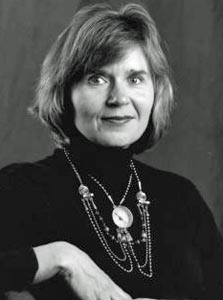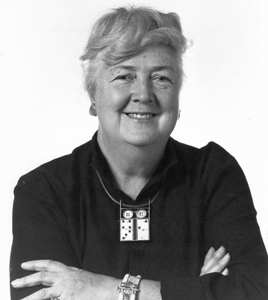Related Research Articles
Eyebeam is a not-for-profit art and technology center in New York City, founded by John Seward Johnson III with co-founders David S. Johnson and Roderic R. Richardson.
Matthew Ritchie is a British artist who currently lives and works in New York City. He attended the Camberwell School of Art from 1983 to 1986. He describes himself as "classically trained" but also points to a minimalist influence. His art revolves around a personal mythology drawn from creation myths, particle physics, thermodynamics, and games of chance, among other elements.
Kiff Slemmons is a contemporary American metalsmith. She received her B.A. in Art and French at the University of Iowa, but is primarily known for her career in jewelry and metals. Slemmons currently resides in Chicago, Illinois. Her work is collected by many notable museums and personalities, including the late Robin Williams.

Yael Bartana is an Israeli artist, filmmaker and photographer, whose past works have encompassed multiple mediums, including photography, film, video, sound, and installation. Many of her pieces feature political or feminist themes.
Christiane Paul is Curator of Digital Art at the Whitney Museum of American Art and professor emerita in the School of Media Studies at The New School. She is the author of the book Digital Art, which is part of the 'World of Art' series published by Thames & Hudson.
Linda MacNeil is an American abstract artist, sculptor, and jeweler. She works with glass and metal specializing in contemporary jewelry that combines metalwork with glass to create wearable sculpture. Her focus since 1975 has been sculptural objets d’art and jewelry, and she works in series. MacNeil’s jewelry is considered wearable sculpture and has been her main focus since 1996.

Howardena Pindell is an American artist, curator and educator. She is known as a painter and mixed media artist, her work explores texture, color, structures, and the process of making art; it is often political, addressing the intersecting issues of racism, feminism, violence, slavery, and exploitation. She is known for the wide variety of techniques and materials used in her artwork; she has created abstract paintings, collages, "video drawings," and "process art."
Ursula Endlicher is a New York City based Austrian multi-media artist who creates works in the fields of internet art, performance art and installation art.
Vivian Selbo is an American contemporary digital media artist who works as the design director for Slate.
Adrianne Wortzel is an American contemporary artist who utilizes robotics in her installations and performances. She has also created many online works.

Andrea Polli is an environmental artist and writer. Polli blends art and science to create widely varied media and technology artworks related to environmental issues. Her works are presented in various forms, she uses interactive websites, digital broadcasting, mobile applications, and performances, which allows her to reach a wider audience.

Marina G. Zurkow is an American visual artist based in New York City who works with media technology, animation and video. Some of the less traditional mediums are known to be dinners, life science and bio materials. Her subject matter includes individual narratives, environmental concerns, and reflections on the relation between species, or between humans, animals, plants and the weather. Her artworks have been seen in solo exhibitions at DiverseWorks in Houston Texas and at FACT in Liverpool. Zurkow is the recipient of a Creative Capital grant and has had fellowships from the Guggenheim and the Rockefeller Foundation.

Nancy Lee Worden was an American artist and metalsmith. Her jewelry art is known for weaving together personal narratives with current politics. She received many awards and honors. Worden exhibited internationally, and her work is represented in collections around the world, including the Smithsonian American Art Museum and the Museum of Fine Arts, Boston.

Ramona Solberg (1921–2005) created eccentric yet familiar jewelry using found objects; she was an influential teacher at the University of Washington School of Art and is often referred to as the "grandmother of Northwest found-art jewelry". Additionally, she served as an art instructor and a prolific jewelry artist in and around Seattle for three decades.

Kristin Lucas is a media artist who works in video, performance, installation and on the Internet. Her work explores the impacts of technology on humanity, blurring the boundary between the technological and corporeal. In her work she frequently casts herself as the protagonist in videos and performances where her interactions with technology lead to isolation, and physical and mental contamination.

Morehshin Allahyari is an Iranian media artist, activist, and writer based in New York. Her work questions current political, socio-cultural, and gender norms, particularly exploring the relationship between technology, history, and art activism. Allahyari’s artworks include 3D-printed objects, videos, experimental animation, web art, and publications. As a 2017 Research Resident at Eyebeam, Allahyari also worked on the concept of "Digital Colonialism"; a term she has coined since 2015.
Myra Mimlitsch-Gray is an American metalsmith, artist, critic, and educator living and working in Stone Ridge, New York. Mimlitsch-Gray's work has been shown nationally at such venues as the John Michael Kohler Arts Center, Museum of the City of New York, Metropolitan Museum of Art, Cooper-Hewitt Smithsonian Design Museum, and Museum of Arts and Design. Her work has shown internationally at such venues as the Middlesbrough Institute of Modern Art, Stadtisches Museum Gottingen, and the Victoria and Albert Museum, and is held in public and private collections in the U.S, Europe, and Asia.
Sondra Sherman is an American painter and jewelry maker. Sherman's work has been praised for its "deeply personal" expression of human emotion and of the subjects inspired by them. Sherman's skills and reputation as a jeweler have earned her many awards, including a Tiffany Foundation Emerging Artists Award, various fellowships, and a Fulbright Scholarship.
Torkwase Dyson is an interdisciplinary artist based in Beacon, New York, United States. Dyson describes the themes of her work as "architecture, infrastructure, environmental justice, and abstract drawing." Her work is informed by her own theory of Black Compositional Thought. This working term considers how spatial networks—paths, throughways, water, architecture, and geographies—are composed by Black bodies as a means of exploring potential networks for Black liberation. She is represented by Pace Gallery and Richard Gray Gallery.
Shawné Michaelain Holloway is a Chicago-based American new media artist and digital feminist whose practice incorporates sound, performance, poetry, and installation with focuses in new media art, feminist art, net art, digital art. Holloway engages with the rhetoric of technology and sexuality to excavate the hidden architectures of power structures and gender norms.
References
- ↑ Bard, Elizabeth. "A Video Game With Awe as Its Quest" The New York Times. March 21, 2004.
- ↑ Kerr, Dylan. "The Early Disruptors: 7 Masterpieces of '90s Net Art Everyone Should Know About" Artspace. March 27, 2015.
- ↑ List of Artists "Whitney Museum of American Art". 2002 Biennial.
- ↑ Moran, Jarret. "Yael Kanarek: Notyetness" Artlog. September 20, 2010.
- ↑ "TEXTWORKS". YAEL KANAREK. Retrieved March 9, 2021.
- ↑ "Deeply Concentric: An Interview with Yael Kanarek". DAILY SERVING. Retrieved March 22, 2021.
- ↑ "WORLD OF AWE". YAEL KANAREK. Retrieved March 9, 2021.
- ↑ "Yael Kanarek | eyebeam.org". eyebeam.org. Retrieved January 28, 2016.
- ↑ Rachel Greene, Internet Art, Thames & Hudson, Ltd., 2004. ISBN 0-500-20376-8
- ↑ Holland Cotter, Review: The Joys of Childhood Re-examined, The New York Times, March 25, 1994.